#full stack developer
Text
Websites to practice Front-End
(22/02/2023)
Today I wanted to share websites to practice your frontend skills.
Front-end is complicated for my head (ask me to solve an algorithm with structure while but not to center a div HUEHHUE).
BUT at the same time I love a well done and coded design/ui. That's why today I want to share resources to help you train
1- Front-End Practice

They have 3 levels, beginner, intermediate and advanced. There's no "answer" so you can't copy the code, it's just you trial and error until you get to the template (which really is a website that exists)

One thing I thought was really cool here was that it tells you what you're going to practice the most in the exercise, color palette and search features.
It's very interesting for a front-end not to be dependent on a tutorial, because from what I've seen in interviews, they ask you to make a layout and you won't be able to make one yourself if you don't learn to break down a single layout from the beginning and try and making mistakes until it's perfect.
2- DevChallenges
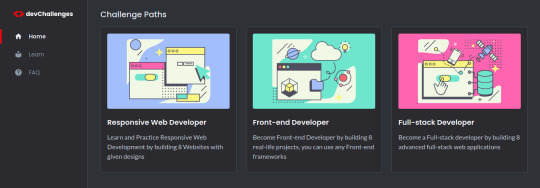
I find the projects not only beautiful visually but also interesting to practice. Here you already have the solutions that other people recommend, but again I think it's best for us to try and make mistakes until we get similar.And it also sorts the levels.
Here an example:

Cool huh? Well, I hope this helps someone who is looking for projects to practice with. We can invest a lot of time trying to make a layout, so having something ready I know helps a lot.
I wish you good studies and a great Wednesday, drink water.
#front end#frontenddevelopment#html css#html5#full stack developer#static website design tools#css3#javascript#reactjs#software engineer#practice#studyblr#studyblog#codeblr#resour#study tips
264 notes
·
View notes
Text
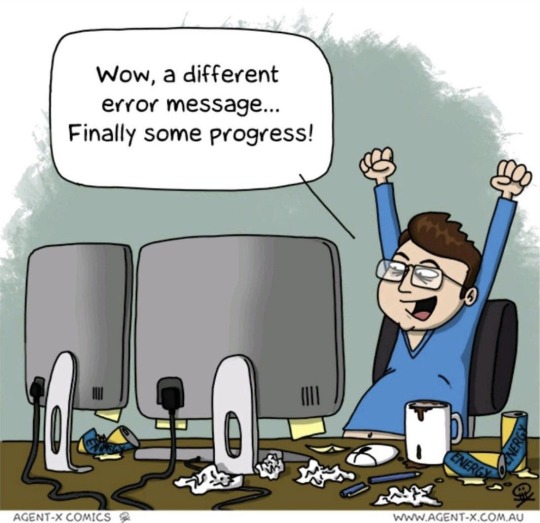
#programmer humor#programming#geek#nerd#programmer#python#laptop#c#meme#pc#software#hardware#software engineer#full stack web development#full stack developer#development#developer#dev#arduino#raspberry pi#computer science#agent-x-comics
757 notes
·
View notes
Text
Frontend Projects Ideas
ADVANCED
1. E-commerce Website
2. Social Network
3. Online Learning Platform
4. Music Streaming Service
5. Real Estate Listing
6. Project Management Tool
7. Chatbot Interface
8. Job Board
9. Weather Forecast with Al
10. Stock Trading Platform
11. loT Dashboard
12. Voice Assistant Interface
13. Expense Report Generator
14. Augmented-Reality App
15. Interactive 3D Graphics
16. Blockchain Explorer
17. Machine-Learning Dashboard
18. Language Learning App
19. Financial Planning
20. Astronomy Viewe
#codeblr#code#coding#learn to code#progblr#programming#software#studyblr#front end developers#front end development#web developers#full stack web development#full stack developer#full stack development#learning#tech#technology#my projects
22 notes
·
View notes
Text
A question for all the developpers and coders here
Like how to improve myself in coding. The problem with me is that I don't grasp concepts well; I can learn something theoretically, but I forget it quickly. I tend to resort to copying and pasting from YouTube tutorials without fully understanding what i'm copying or even like take code from chatgbt , and I struggle with breaking down larger projects into smaller tasks. I don't know where to start or which method to follow. I feel stupid .
#cs major#web development#full stack developer#help#please help#advice#coding#programming#progblr#codeblr#computer science#stuck in the middle
15 notes
·
View notes
Text
The Roadmap to Full Stack Developer Proficiency: A Comprehensive Guide
Embarking on the journey to becoming a full stack developer is an exhilarating endeavor filled with growth and challenges. Whether you're taking your first steps or seeking to elevate your skills, understanding the path ahead is crucial. In this detailed roadmap, we'll outline the stages of mastering full stack development, exploring essential milestones, competencies, and strategies to guide you through this enriching career journey.

Beginning the Journey: Novice Phase (0-6 Months)
As a novice, you're entering the realm of programming with a fresh perspective and eagerness to learn. This initial phase sets the groundwork for your progression as a full stack developer.
Grasping Programming Fundamentals:
Your journey commences with grasping the foundational elements of programming languages like HTML, CSS, and JavaScript. These are the cornerstone of web development and are essential for crafting dynamic and interactive web applications.
Familiarizing with Basic Data Structures and Algorithms:
To develop proficiency in programming, understanding fundamental data structures such as arrays, objects, and linked lists, along with algorithms like sorting and searching, is imperative. These concepts form the backbone of problem-solving in software development.
Exploring Essential Web Development Concepts:
During this phase, you'll delve into crucial web development concepts like client-server architecture, HTTP protocol, and the Document Object Model (DOM). Acquiring insights into the underlying mechanisms of web applications lays a strong foundation for tackling more intricate projects.
Advancing Forward: Intermediate Stage (6 Months - 2 Years)
As you progress beyond the basics, you'll transition into the intermediate stage, where you'll deepen your understanding and skills across various facets of full stack development.
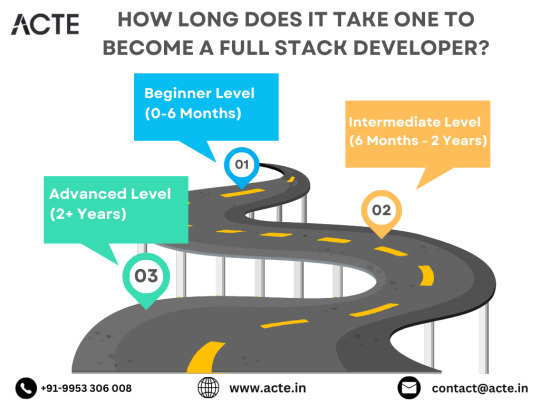
Venturing into Backend Development:
In the intermediate stage, you'll venture into backend development, honing your proficiency in server-side languages like Node.js, Python, or Java. Here, you'll learn to construct robust server-side applications, manage data storage and retrieval, and implement authentication and authorization mechanisms.
Mastering Database Management:
A pivotal aspect of backend development is comprehending databases. You'll delve into relational databases like MySQL and PostgreSQL, as well as NoSQL databases like MongoDB. Proficiency in database management systems and design principles enables the creation of scalable and efficient applications.
Exploring Frontend Frameworks and Libraries:
In addition to backend development, you'll deepen your expertise in frontend technologies. You'll explore prominent frameworks and libraries such as React, Angular, or Vue.js, streamlining the creation of interactive and responsive user interfaces.
Learning Version Control with Git:
Version control is indispensable for collaborative software development. During this phase, you'll familiarize yourself with Git, a distributed version control system, to manage your codebase, track changes, and collaborate effectively with fellow developers.
Achieving Mastery: Advanced Phase (2+ Years)
As you ascend in your journey, you'll enter the advanced phase of full stack development, where you'll refine your skills, tackle intricate challenges, and delve into specialized domains of interest.
Designing Scalable Systems:
In the advanced stage, focus shifts to designing scalable systems capable of managing substantial volumes of traffic and data. You'll explore design patterns, scalability methodologies, and cloud computing platforms like AWS, Azure, or Google Cloud.
Embracing DevOps Practices:
DevOps practices play a pivotal role in contemporary software development. You'll delve into continuous integration and continuous deployment (CI/CD) pipelines, infrastructure as code (IaC), and containerization technologies such as Docker and Kubernetes.
Specializing in Niche Areas:
With experience, you may opt to specialize in specific domains of full stack development, whether it's frontend or backend development, mobile app development, or DevOps. Specialization enables you to deepen your expertise and pursue career avenues aligned with your passions and strengths.
Conclusion:
Becoming a proficient full stack developer is a transformative journey that demands dedication, resilience, and perpetual learning. By following the roadmap outlined in this guide and maintaining a curious and adaptable mindset, you'll navigate the complexities and opportunities inherent in the realm of full stack development. Remember, mastery isn't merely about acquiring technical skills but also about fostering collaboration, embracing innovation, and contributing meaningfully to the ever-evolving landscape of technology.
#full stack developer#education#information#full stack web development#front end development#frameworks#web development#backend#full stack developer course#technology
6 notes
·
View notes
Text
Full Stack Developer vs. Front End Developer vs. Back End Developer
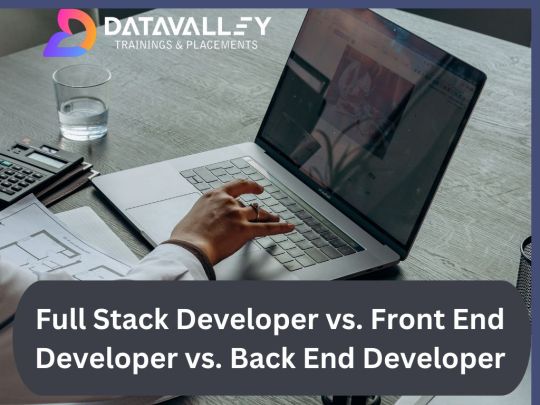
The role of a web developer is always included in the lists of high-paying IT jobs. This is because web developers are essential in today’s digital world. They create amazing websites, high-performing e-commerce sites, and other web-based applications. If you want to be a web developer, you must understand that full-stack developer skills are in great demand. However, do you understand the differences between full-stack, front-end, and back-end web development? In this post, we’ll see the differences between these three job roles, skills, and salaries.
What is Web Development?
The process of developing a website on the internet is known as web development. The non-design components of a website, such as building features and functioning with programming, markup, and scripting languages, are referred to as web development. Developers focus on technical aspects of website development such as architecture, programming, and application integration, as well as visuals.
A web developer is someone who does the following:
Creates and maintains webpages and other web-based applications.
Creates a website from a web design.
They collaborate with clients, stakeholders, and designers to understand the concept.
Can focus on frontend or backend development. Even as a full-stack developer, if necessary.
Types of Web Development
Front End Development: This aspect of web development focuses on what the user interacts with directly, i.e., the user interface of a website or web application. Front-end development deals with the design, layout, and interactivity of a site, ensuring that it’s visually appealing and user-friendly.
Back End Development: The back end is the part of a website or application that operates behind the scenes. It manages data, user authentication, and the server-side logic, ensuring the smooth functioning of the website.
Now, let’s delve into each of these roles in detail.
What is front-end development?
Front-end development, often referred to as client-side development, is the process of creating the visual elements of a website or web application that users interact with directly. It involves writing code for the user interface, optimizing website performance, and ensuring the site looks and functions correctly on various devices and browsers.
Who is a front-end developer?
A front-end developer, also known as a client-side developer, is responsible for turning web designs into a functioning website or application. They work closely with web designers and back-end developers to create an engaging and responsive user experience.
What are the front-end developer’s skills?
Front-end developers should be proficient in the following skills:
Mastery of HTML (Hypertext Markup Language) and CSS (Cascading Style Sheets) is fundamental for structuring and styling web pages.
Proficiency in JavaScript is crucial for adding interactivity and dynamic features to a website.
Knowledge of front-end frameworks like React, Angular, or Vue.js, which simplify and expedite development.
The ability to create websites that look and function well on various devices and screen sizes.
Ensuring that the website performs consistently across different browsers.
Familiarity with version control systems like Git for code management and collaboration.
Front End Developer Salary
The salary of a front-end developer can vary based on factors such as experience, location, and the company. On average, junior front-end developers can earn between $50,000 and $70,000 annually, while senior front-end developers can command salaries ranging from $90,000 to $120,000 or more.
What is Back End Development?
Back-end development, often referred to as server-side development, focuses on the server and database sides of a website or web application. It involves building and maintaining the server, databases, and applications that enable the front end to function correctly.
Who is a Back End Developer?
A back-end developer is responsible for managing the server, databases, and server-side logic of a website or application. They ensure that data is stored securely, accessed efficiently, and transmitted effectively between the front end and back end.
What are Back End Developer Skills?
Back-end developers should have expertise in the following areas:
Server-Side Programming Languages: Proficiency in languages such as Python, Ruby, Node.js, PHP, or Java is used to build server-side applications.
Databases: Knowledge of database management systems like MySQL, PostgreSQL, MongoDB, and NoSQL databases.
APIs: The ability to create and manage APIs (Application Programming Interfaces) for communication between the front end and back end.
Server Management: Skills in managing web servers and server infrastructure.
Security: Understanding web security practices and techniques to protect user data.
Version Control/Git: Proficiency in version control systems to manage and collaborate on code.
Back End Developer Salary
Back-end developer salaries can also vary based on experience, location, and the organization. Junior back-end developers can earn an annual salary ranging from $60,000 to $90,000, while senior back-end developers can expect salaries ranging from $100,000 to $150,000 or more.
Frontend vs. Backend Development
Front-end and back-end development are two halves of a whole, and they must work together seamlessly to create a functional website or application. While front-end developers focus on user interface and design, back-end developers deal with the underlying server infrastructure and data management. Both roles are essential for a successful web project.

What is a Full Stack Developer?

Who is a Full Stack Developer?
A full stack developer is a well-rounded professional who can take care of every aspect of web development, from designing the user interface to managing databases and server-side logic. They bridge the gap between front end and back-end development, ensuring that the entire application functions cohesively.
What are the Full Stack Developer Skills?
Full stack developers need a broad range of skills, including:
HTML/CSS: Proficiency in front end technologies for web page structuring and styling.
JavaScript: Mastery of JavaScript for creating dynamic and interactive web elements.
Front End Frameworks: Knowledge of front-end frameworks for efficient development.
Server-Side Programming Languages: Expertise in languages like Node.js, Python, Ruby, or Java for server-side development.
Databases: Proficiency in database management systems for data storage and retrieval.
APIs: Ability to create and manage APIs for communication between the front end and back end.
Version Control/Git: Familiarity with version control systems for code management.
Problem-Solving: Strong analytical and problem-solving skills to troubleshoot and optimize web applications.
Full Stack Developer Salary
Full-stack web developers are in high demand due to their range of skills and extensive knowledge. An average full stack developer’s annual salary might range from $110,000 to $150,000, based on their skill set and expertise.
Full-stack engineers earn more money than front end or back end developers. Employers agree to pay more for a full stack developer since it makes more business sense to hire one person with front and back end expertise rather than two.
As a result, the profession of a full stack developer is a profitable alternative for aspirants looking to create a career in the digital business.
The choice between becoming a full stack developer, front end developer, or back end developer depends on your interests, strengths, and career goals. Front end developers excel at creating visually appealing and user-friendly interfaces; back end developers focus on the server-side and data management; and full stack developers possess a comprehensive skill set that allows them to manage the entire development process. Each role is integral to the web development ecosystem, and the right one for you depends on your passions and aspirations within the field.
If you’re considering the path of a full stack developer and are eager to acquire the comprehensive skill set required to excel in this role, we have an excellent suggestion for you. Consider enrolling in the Full Stack Developer course at Datavalley.
Datavalley has a stellar track record of empowering aspiring developers with the knowledge and expertise to succeed in the dynamic world of web development. Their course covers everything from the fundamentals of HTML and CSS to in-depth training in JavaScript, front end and back end frameworks, and much more.
By joining Datavalley’s Full Stack Developer course, you’ll gain hands-on experience, build an impressive portfolio, and be well-prepared for a rewarding career in web development.
Don’t miss out on this opportunity to kickstart your journey as a Full Stack Developer with Datavalley. Your future in web development awaits. Take the first step today!
Attend Free Bootcamp at Datavalley
If you’re looking to supercharge your Java development skills and become a full-stack Java developer, consider joining the Java Full Stack Developer bootcamp at Datavalley. It’s an excellent opportunity to enhance your expertise and take your career to the next level.
Key points about Bootcamps:
It is completely free, and there is no obligation to complete the entire course.
20 hours total, two hours daily for two weeks.
Gain hands-on experience with tools and projects.
Explore and decide if the field or career is right for you.
Complete a mini project.
Earn a certificate to show on your profile.
No commitment is required after bootcamp.
Take another bootcamp if you are unsure about your track.
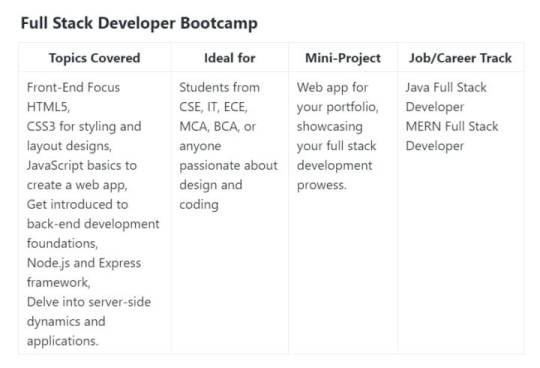
#datavalley#dataexperts#data engineering#data analytics#dataexcellence#business intelligence#data science#power bi#data analytics course#data science course#full stack course#full stack training#full stack web development#full stack developer#full stack software developer#front end developers#back end development
5 notes
·
View notes
Text
#code#full s#full stack course#full stack training#full stack web development#full stack developer#course#training#curse in pune
2 notes
·
View notes
Text

🚀 Join the Ultimate Engineering College Quiz Challenge! 🚀🏏
🌟 Test Your IPL Knowledge and Full Stack Development Skills! 🌟
🏆 Prizes Await the Top Scorers! 🏆
Ready to flaunt your smarts? Dive into our dynamic quiz featuring 10 IPL questions and 10 Full Stack Development questions. From cricket trivia to coding conundrums, we've got it all!
🏆 Prizes:
🥇 1st Place: ₹2000 Cash Prize
🥈 2nd Place: Official Merchandise
🥉 3rd Place: Electronic Merchandise
🔗 Ready for the Challenge? Click Here : https://forms.gle/xGrMcnar3xJHS7TS9
to start the quiz and seize your chance to win big! 🚀
Let the games begin! 🎉
2 notes
·
View notes
Text
The Profound Benefits of Embracing Full Stack Development
Introduction: In the dynamic realm of software development, full stack developers have emerged as indispensable assets, equipped with the skills to navigate both front-end and back-end technologies seamlessly. This comprehensive exploration sheds light on the multifaceted advantages of embracing full stack development, unveiling the unique benefits and opportunities that accompany proficiency in both facets of the development stack.

Unlocking the Benefits of Full Stack Development:
Versatility and Adaptability: Full stack developers possess a diverse skill set, encompassing proficiency in both front-end and back-end technologies. This versatility enables them to fluidly transition between different aspects of development, adeptly adapting to project requirements and challenges.Mastery of client-side and server-side technologies empowers full stack developers to tackle a myriad of tasks, from crafting intuitive user interfaces to implementing complex business logic. This adaptability renders them invaluable assets to development teams, capable of contributing to various stages of the software development lifecycle with finesse.
Comprehensive Project Ownership: A defining advantage of full stack developers lies in their ability to assume end-to-end ownership of projects, from inception to deployment. With a comprehensive understanding of both front-end and back-end technologies, full stack developers can oversee all facets of development, ensuring seamless integration and coherence throughout the project lifecycle.This holistic perspective empowers full stack developers to make informed decisions at every juncture of development, from conceptualization and architecture to execution and optimization. By embracing responsibility for the entire project, full stack developers drive efficiency, consistency, and quality, culminating in successful project outcomes.
Expanded Employability and Career Prospects: Full stack developers are highly coveted by employers owing to their diverse skill set and capacity to work across multiple technologies. Proficiency in both front-end and back-end technologies opens the door to a plethora of career opportunities across various industries and sectors.Employers prize full stack developers for their adaptability, versatility, and ability to deliver end-to-end solutions that align with business objectives. Whether it entails developing web applications, mobile apps, or enterprise software, full stack developers are poised to excel in diverse roles and environments, making them sought-after candidates in the job market.
Efficient Collaboration and Communication: Full stack developers excel in cross-functional collaboration, proficiently communicating with designers, product managers, and fellow developers alike. Their grasp of both front-end and back-end technologies bridges the gap between different teams and departments, fostering smoother communication and collaboration.This collaborative prowess enables full stack developers to seamlessly integrate with cross-functional teams, ensuring that project requirements are comprehended, feedback is incorporated, and deliverables are met punctually and within budget constraints. By fostering a culture of collaboration and synergy, full stack developers contribute significantly to project success and organizational growth.
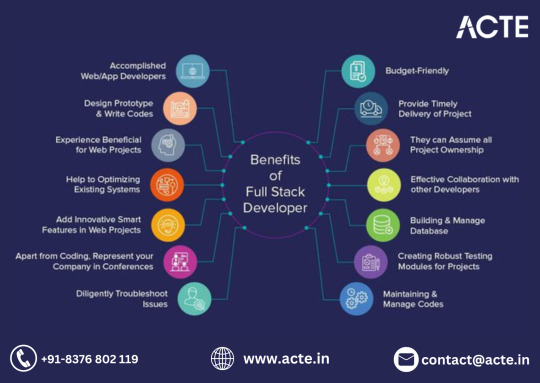
Agile Prototyping and Iteration: Full stack developers possess a knack for rapid prototyping and iteration, leveraging their comprehensive understanding of both front-end and back-end technologies. This proficiency enables them to swiftly prototype and iterate on features, accelerating development cycles and fostering innovation.By gathering feedback iteratively and swiftly incorporating user input and stakeholder feedback, full stack developers expedite the development process. This agile approach allows them to identify and address issues promptly, resulting in faster development cycles and heightened product quality.
Holistic Problem-Solving Proficiency: Full stack developers boast holistic problem-solving skills, enabling them to tackle challenges across the user interface and server layers. With an in-depth comprehension of both front-end and back-end technologies, full stack developers approach problems from diverse angles, exploring a plethora of solutions and technologies to pinpoint the most effective remedy.This comprehensive problem-solving approach fosters creativity, innovation, and critical thinking, as full stack developers explore various methodologies and techniques to resolve intricate problems. By harnessing their diverse skill set and experience, full stack developers surmount obstacles and deliver innovative solutions that cater to user needs and business imperatives.
Continuous Learning and Professional Growth: Full stack development is an ever-evolving domain that encourages continuous learning and professional growth. With new technologies, frameworks, and best practices perpetually emerging, full stack developers have ample opportunities to augment their skill set and remain abreast of industry trends.Continuous learning is inherent to the full stack developer role, necessitating a commitment to staying abreast of the latest advancements in both front-end and back-end technologies. By investing in continuous learning and professional development, full stack developers remain competitive in the job market and position themselves for sustained success in their careers.
Conclusion: In summary, embracing full stack development bestows a myriad of advantages and opportunities, ranging from versatility and end-to-end project ownership to enhanced employability and continuous learning. By mastering both front-end and back-end technologies, full stack developers are primed to excel in diverse roles and environments, driving innovation and success in the ever-evolving sphere of software development. Whether you're an established developer or an aspiring professional, embracing full stack development opens doors to a world of possibilities and professional fulfillment.
#full stack course#full stack developer#full stack software developer#full stack training#full stack web development
4 notes
·
View notes
Text
#full stack web development#full stack training#full stack python training in ameerpet#full stack developer#full stack software developer
2 notes
·
View notes
Text
Learning Python: Day 12
(08/01/2023)
Explain the problem: Write a program to read an integer N (maximum = 10) and a square matrix of order N containing integers. Then show the main diagonal and the amount of values matrix negative.


I finished the conversions from portugol to python with the matrix and vector modules.
I was also going to continue the basics of Html in Odin but I spent the day organizing my studies (not just programming) for the month and I ended up running out of energy, so I did what was necessary to finish this part and today 09/01 (here it's midnight ) start 100 days of code Python.
I also had the idea of starting my algorithm practices using the leet code, it will be interesting because I will be 100% alone, since in Portugal I had the teacher's corrections.
So a good way to push myself to improve even more.
I wish you are well, have a great week and drink water.
#computers#studyblr community#comp sci#computing#computer science#junior developer#software development#development#full stack developer#pythonprogramming#python#pythonforbeginners#pythoncode#algorythm#algorithms#studyblog#stemblr#studyblr#codeblr#100 days of productivity#100daysofcode#discipline#woman in stem#womanintech
33 notes
·
View notes
Text
Mastering Full Stack Development: A Beginner's Guide to Full Stack Web Development Course
Introduction:
In the fast-paced world of web development, versatility is key. Full stack development has emerged as a comprehensive approach that allows developers to work on both the frontend and backend of web applications. If you're eager to embark on a journey into the realm of Full Stack Web Development courses, you're in the right place. This beginner's guide will provide you with a solid foundation and equip you with the essential knowledge to kickstart your career in this exciting field.
I. Understanding Full Stack Development II. Essential Technologies and Tools III. Learning Path and Resources IV. Building Your First Full Stack Project
I. Understanding Full Stack Development:
Full stack development refers to the practice of working on both the client-side (frontend) and server-side (backend) of web applications. This holistic approach enables developers to create fully functional and dynamic websites or applications. In a Full Stack Web Development course, you'll delve into various programming languages, frameworks, and databases, gaining a comprehensive understanding of the entire development process.
II. Essential Technologies and Tools:
To excel in full stack development, you'll need to familiarize yourself with a plethora of technologies and tools. On the frontend, popular frameworks like React, Angular, or Vue.js are widely used for building interactive user interfaces. On the backend, Node.js, Django, or Ruby on Rails are among the top choices for server-side development. Additionally, mastering database management systems such as MySQL, MongoDB, or PostgreSQL is crucial for storing and retrieving data efficiently.
III. Learning Path and Resources:
Embarking on a Full Stack Web Development course requires a structured learning path and access to reliable resources. Online platforms like Coursera, Udemy, or Codecademy offer comprehensive courses that cover the fundamentals of full stack development. Additionally, community forums, coding bootcamps, and developer communities can provide invaluable support and guidance throughout your learning journey.
IV. Building Your First Full Stack Project:
The best way to solidify your understanding of full stack development is by building real-world projects. Start with a simple application and gradually increase the complexity as you gain confidence. Utilize the skills and knowledge acquired from your Full Stack Web Development course to design, develop, and deploy your own full stack project. This hands-on experience will not only reinforce your learning but also showcase your abilities to potential employers or clients.
Conclusion:
Congratulations on taking the first step towards mastering Full Stack Web Development! As you continue on your learning journey, remember that persistence and practice are key. Whether you're a student aspiring to enter the tech industry or a working professional looking to upskill, the world of full stack development offers endless opportunities for growth and innovation. Feel free to share your thoughts or questions in the comments below. We'd love to hear from you!
Ready to dive deeper into Full Stack Web Development? Enroll in BIA's Full Stack Web Development course today and unlock your potential in this dynamic field!
#web development#full stack developer#full stack web development#full stack course#full stack training
6 notes
·
View notes
Text
Frontend Projects Ideas
INTERMEDIATE
1. Chat Application
2. Expense Tracker
3. Weather Dashboard
4. Portfolio CMS
5. Blog CMS
6. Interactive Maps Data
7. Weather-App
8. Geolocation
9. Task Management App
10. Online Quiz Platform
11. Calendar App
12. Social-Media Dashboard
13. Stock Market Tracker
14. Travel Planner
15. Online Code Editor
16. Movie Database
17. Recipe-Sharing Platform
18. Portfolio Generator
19. Interactive-Data Visualization
19..Pomodoro Timer
20.Weather Forecast App
#codeblr#code#coding#learn to code#progblr#programming#software#studyblr#full stack development#full stack developer#full stack web development#webdevelopment#front end developers#front end development#technology#tech#web developers#learning
13 notes
·
View notes
Text

A clutter-free workspace gets me in the right mindset to work on a project.
#web designer#web developer#full stack developer#web design#digital marketing#website#web development#women in tech#women in stem#work in progress
2 notes
·
View notes
Text
Unveiling the Essential Role of Full Stack Developers in Modern Web Development
Introduction:
Within the dynamic realm of web development, full stack developers stand out as indispensable assets, offering a unique blend of expertise in both frontend and backend technologies. Their versatility enables them to navigate through various aspects of web application development, from crafting user interfaces to managing databases and server-side logic.

In this article, we'll delve into the essential role of full stack developers, shedding light on their pivotal contributions to streamlining development processes and fostering innovation within the industry.
1. Comprehensive Development Capabilities:
An integral aspect of full stack developers lies in their adeptness at overseeing end-to-end development projects. From initial concept to deployment, these professionals are proficient in every stage of the development lifecycle. They excel at designing intuitive user interfaces, implementing intricate frontend functionality, crafting robust backend logic, seamlessly integrating databases, and orchestrating smooth deployment of applications. This holistic approach ensures coherence and uniformity across the entirety of the project.
2. Proficient Problem Solvers:
Full stack developers possess a profound understanding of both frontend and backend technologies, equipping them with the skills to address issues at varying levels of the application stack. Their extensive skill set enables them to identify and resolve challenges efficiently, thereby minimizing downtime and ensuring the seamless operation of web applications. Whether it entails debugging frontend UI glitches or optimizing backend performance, full stack developers excel in devising effective solutions to intricate technical hurdles.
3. Collaborative Cross-Functional Engagement:
Effective collaboration is paramount in any development endeavor, and full stack developers are adept at fostering cross-functional teamwork. With their comprehensive grasp of frontend and backend technologies, they facilitate seamless communication and collaboration among designers, frontend developers, backend developers, and project managers. This cohesive teamwork ensures alignment on project objectives and facilitates smooth execution of tasks throughout the development journey.
4. Streamlined Development Processes:
The presence of a single developer proficient in both frontend and backend tasks results in a more streamlined and efficient development process. Full stack developers seamlessly transition between frontend and backend development, thereby mitigating communication gaps and reducing the need for handoffs between different team members. This streamlined approach translates into faster development cycles, rapid iterations, and ultimately, shortened time-to-market for web applications.

5. Adaptability to Technological Advancements:
In a landscape characterized by constant evolution, full stack developers are well-equipped to adapt to emerging trends and integrate new technologies into their projects. Their ability to stay abreast of the latest developments ensures they remain at the forefront of innovation in web development, thereby enabling them to deliver cutting-edge solutions tailored to meet the evolving needs of clients and users alike.
6. Cost-Efficiency:
Employing separate specialists for frontend and backend development can incur substantial costs for businesses. Conversely, engaging a full stack developer who can adeptly handle both roles offers a more cost-effective alternative. This approach not only reduces development expenditures but also minimizes overhead and administrative burdens associated with project management. Furthermore, having a singular point of contact for development tasks enhances communication and expedites decision-making processes.
7. Versatility in Project Execution:
Full stack developers possess the versatility to tackle a diverse array of projects, ranging from simple websites to complex web applications. This flexibility enables them to address varied challenges and contribute effectively to a wide spectrum of projects. Whether it involves crafting e-commerce platforms, content management systems, or social networking sites, full stack developers boast the expertise and adaptability to deliver bespoke solutions tailored to the unique requirements of each project.
8. Ownership and Commitment:
Often assuming ownership of the projects they undertake, full stack developers exhibit a heightened sense of accountability and dedication. This intrinsic ownership fosters a greater commitment to project success, as developers become personally invested in achieving favorable outcomes. By assuming responsibility for the entire development process, full stack developers ensure projects are delivered punctually, within budget constraints, and in adherence to the highest quality standards.
Conclusion:
In summary, full stack developers occupy a pivotal position in the realm of web development, leveraging their versatile skill sets and comprehensive understanding of frontend and backend technologies to drive innovation and excellence. By harnessing the unique capabilities of full stack developers, businesses can streamline development processes, stimulate innovation, and deliver unparalleled web experiences to their audience.
#full stack developer#education#information#full stack web development#front end development#frameworks#web development#backend#full stack developer course#technology
4 notes
·
View notes
Text
Full Stack Developer Course in Varanasi with Placement.
The Full Stack Development Course in Varanasi offers a comprehensive curriculum covering both front-end and back-end technologies. Designed to impart a well-rounded skill set, the course equips participants with proficiency in various programming languages, frameworks, and tools essential for full stack development. Emphasizing practical learning, the program provides hands-on experience in building and deploying applications, ensuring students are well-prepared for real-world challenges. This Full Stack Development course in Varanasi follows industry best practices, preparing participants for a successful career in the dynamic and evolving field of full stack development.

2 notes
·
View notes